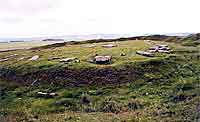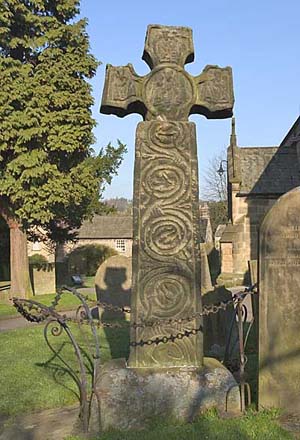In Derbyshire, Celtic traditions live on, the hills breathe the atmosphere of the Celts, and their lore is practiced, as in no other county. The Celts world was a world of spirits, where death was a half way stage. The spirits dwelled in the earthworks, of which their are plenty in Derbyshire.
Water and especially springs were important to the Celts, for they were the offerings of the Earth Mother, the triad, carrying cornucopeas, the horns of plenty, infants and baskets of fruit. These special places are remembered in Derbyshire by the Well Dressings, most of which have been recent revivals. They are now elaborate affairs but originally the water source would have been adorned with simple garlands. The earliest Dressings are those at Tissington village, uninterupted since 1615. In Celtic times wells would have been dressed for Beltane, 1st May, to ensure a good flow of water during the oncoming season but present day wells are dressed throughout the summer season.

Arbor Low |

Celtic Cross at Eyam |
The Latin name for Buxton was Aquae Arnemetiae, the prefix aquae literally means 'of the waters', and was used by the Romans to denote natural spa's or springs. The second part of the name is associated with the Celtic word Nemeton or "sacred grove", which here seems to be used in the plural form. We can readily assume from the Celtic origins of the Roman name for Buxton that the natural springs here represented a religious centre of some considerable importance, probably used by many generations of native Britons prior to the coming of Rome.
The Celts were tribal warriors who loved to fight with death holding no fears. Lugh was a Sun God and a warrior King. The tradition of warrior kings is passed down through legend. One Sir Gawain slew the Green Knight in Lud's Church, just west of Gradbach, a spectacular chasm above the river Dane, dank, chill and with an air of mystery which accords well with the tales of green men and ceremonies. The Celts were head hunters, keeping the skulls of those the killed, in special places. One tradition has it that the football game now placed at ashbourne at Shrovetide was once placed with a human skull for a ball. Was shrovetide football a sacrificial rite to commemorate a battle won?
Throughout Derbyshire, crudely carved heads may be encountered built into walls, houses and churches. There is one at Brassington Church and another, a representation of Sheela-na-gig, the godess of creation and destruction, at Melbourne church.
Hob's place in folk lore is Celtic in design if not in fact. He was a wood elf who brought good works or mischief into the household. Until recent times a bowl of cream was left on many a Derbyshire hearth to ensure that he did good for the household. Several references to Hob occur on the Derbyshire map. Hob's Hurst House is in Deep Dale south of King Sterndale. Close by is a spring which Hob blessed, it is said to have curative properties for those who bathe in its waters on Good Friday. Hob's Hurst House is in Monsal Dale and Hob Hurst's House is a tumulus on Beeley Moor, an area the Celts knew well. There is a legend that here once stood a prosperous market town called Leash Fen.
The Celts worshipped stones in various forms; monoliths, menhirs and circles, mostly dating from an earlier culture. There is evidence that the Celts danced around standing stones forming a circle of people, holding hands in an unbroken chain. It was believed to be a means of gaining power from a monolith. Church clipping at Wirksworth, where people likewise hold hands and surround the church is of ancient origin. It went out of practice but was restarted in 1921 and takes place on the Sunday nearest the 8th September. Burbage holds a similar ceremony. Derbyshire abounds in monoliths and stone circles and the Celts worshipped them. The also worshipped naturally occurring stones such as Eagle Stone on Baslow Edge, a corruption of Aigle's Stone, named after a Celtic Diety who threw large stones.
There are several Celtic crosses in the county, the most outstanding being the one at Eyam's church.
More about the Celts in general can be found at Celtic Twilight
Further reading can be had from 'Celtic Derbyshire' by Peter Naylor ISBN 0 946404 10 0, a part of the Derbyshire Heritage series.